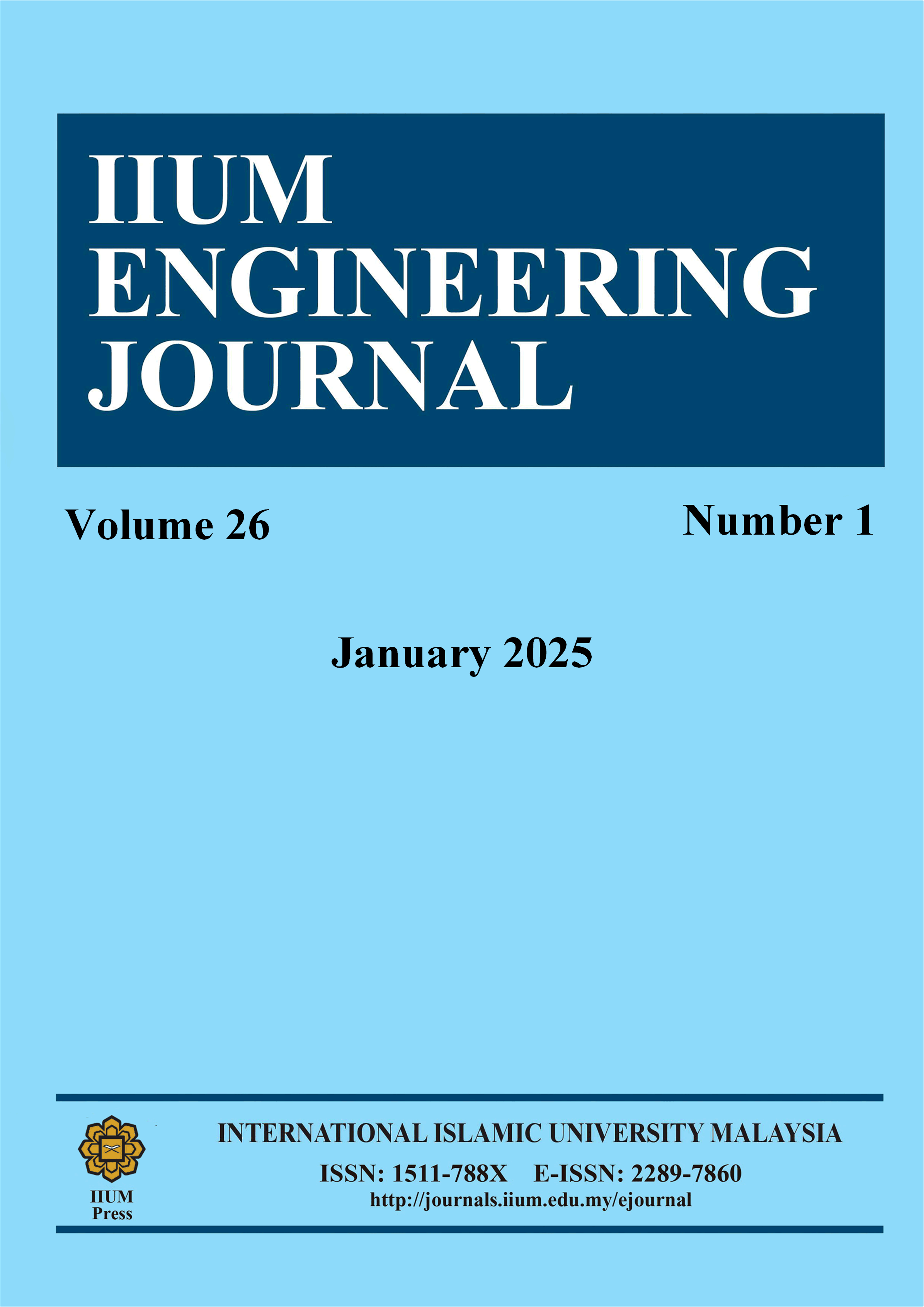Factors Influencing the Elastic Stiffness Factor in Reinforced Concrete Structures of Dual Systems Using Pushover Analysis
DOI:
https://doi.org/10.31436/iiumej.v26i1.3321Keywords:
Reinforced concrete structure, Pushover analysis, Dual system, Base shear, Elastic stiffness factorAbstract
Stiffness is one of the most critical characteristics of a building, which is considered for public safety against earthquake loads and refers to displacement resistance. Buildings must be built with proper strength and stiffness. This study uses pushover analysis to evaluate the parameters influencing the stiffness of the RC Dual system. The research used ASCE 7-10 and ACI 318-08 codes to design 24 two-dimensional buildings. Pushover analysis is conducted in the models using the ETABS software. Factors, including the number of stories, span length, thickness of the shear walls, and compressive strength, were considered while evaluating the stiffness and base shear of the designed buildings. The highest stiffness factor is (149.30) found in low-rise buildings with smaller span lengths, higher shear wall thickness, and higher compressive strength. In comparison, the lowest stiffness factor of (27.88) appeared in high-rise buildings with longer span lengths, lower shear wall thickness, and lower compressive strength. This study analyzed a dual system consisting of a moment-resisting frame and a shear wall. In further studies, other structural systems can be considered. By increasing the span length from 5.5m to 6.5m, the stiffness factor decreases by 8%. While by increasing shear wall thickness, the stiffness factor increased by 4.5%. Since every sample consists of two-dimensional dual systems, the influence of torsion is avoided. Future work should take torsional impacts into account since they have the potential to impact the design.
ABSTRAK: Untuk menyediakan keselamatan umum terhadap daya gempa, salah satu ciri bangunan yang paling penting ialah kekakuan, yang menerangkan tentangan terhadap anjakan. Bangunan mesti dibina dengan kekuatan dan kekakuan yang betul. Kajian ini menggunakan analisis pushover untuk menilai parameter yang mempengaruhi kekukuhan sistem RC Dual. Penyelidikan menggunakan kod ASCE 7-10 dan ACI 318-08 untuk mereka bentuk 24 bangunan dua dimensi. Analisis pushover dijalankan dalam model menggunakan perisian ETABS. Beberapa faktor, termasuk bilangan tingkat, panjang rentang, ketebalan dinding ricih, dan kekuatan mampatan, diambil kira semasa menilai kekukuhan dan ricih asas bangunan yang direka bentuk. Faktor kekukuhan tertinggi yang diukur dengan membahagikan ricih asas kepada anjakan (149.30) muncul di bangunan bertingkat rendah dengan panjang rentang yang lebih kecil, ketebalan dinding ricih yang lebih tinggi, dan kekuatan mampatan yang lebih tinggi. Manakala faktor kekakuan terendah (27.88) terdapat pada bangunan bertingkat tinggi dengan panjang rentang yang lebih panjang, ketebalan dinding ricih yang lebih rendah, dan kekuatan mampatan yang lebih rendah. Hanya kerangka tahan momen dengan dinding ricih yang dipanggil model (sistem dwi) telah dianalisis dalam kajian ini; sistem struktur lain boleh dipertimbangkan dalam kajian lanjut. Dengan meningkatkan panjang rentang daripada 5.5m kepada 6.5m, faktor kekakuan berkurangan sebanyak 8%. Manakala dengan meningkatkan ketebalan dinding ricih, faktor kekakuan meningkat sebanyak 4.5%. Memandangkan setiap sampel terdiri daripada sistem dwi dua dimensi, pengaruh kilasan dielakkan, kerja masa hadapan harus mengambil kira kesan kilasan kerana ia berpotensi memberi kesan kepada reka bentuk.
Downloads
Metrics
References
Behera B, Datta AK, Pal A.(2024). Earthquake resistant design of framed reinforced concrete building using artificial intelligence model. Asian Journal of Civil Engineering. Apr 16:1-4. http://dx.doi.org/10.1007/s42107-024-01051-7 DOI: https://doi.org/10.1007/s42107-024-01051-7
Furtado A, Rodrigues H, Arêde A, Varum H, Grubiši? M, Šipoš TK.(2018). Prediction of the earthquake response of a three-storey infilled RC structure. Engineering Structures. Sep 15;171:214-35. https://doi.org/10.1016/j.engstruct.2018.05.054 DOI: https://doi.org/10.1016/j.engstruct.2018.05.054
Ngenge JP, Wafi AM.(2020). Assessment of plastic hinge in RC structures with and without shear walls applying pushover analysis. International Journal of Advanced Engineering, Sciences and Applications. Jan 30;1(1):11-8. https://doi.org/10.47346/ijaesa.v1i1.27 DOI: https://doi.org/10.47346/ijaesa.v1i1.27
Resatoglu R, Jkhsi S.(2022). Evaluation of Ductility of Reinforced Concrete Structures with Shear Walls having Different Thicknesses and Different Positions. IIUM Engineering Journal. Jul 4;23(2):32-44. https://doi.org/10.31436/iiumej.v23i2.2070 DOI: https://doi.org/10.31436/iiumej.v23i2.2070
AlHassan M, Abdelrahim M.(2020). Plastic hinge assessment of RC moment-resisting frames. International Journal of Advanced Engineering, Sciences and Applications. Jul 15;1(3):37-41. https://doi.org/10.47346/ijaesa.v1i3.29 DOI: https://doi.org/10.47346/ijaesa.v1i3.29
Kamath K, Hirannaiah S, Noronha JC.(2016). An analytical study on performance of a diagrid structure using nonlinear static pushover analysis. Perspectives in Science. Sep 1;8:90-2. https://doi.org/10.1016/j.pisc.2016.04.004 DOI: https://doi.org/10.1016/j.pisc.2016.04.004
Wang Z, Martinez-Vazquez P, Zhao B.(2020). Pushover analysis of structures subjected to combined actions of earthquake and wind. Engineering structures. Oct 15; 221:111034. https://doi.org/10.1016/j.engstruct.2020.111034 DOI: https://doi.org/10.1016/j.engstruct.2020.111034
Sarhan O, Raslan M.(2020). Study of the elastic stiffness factor of steel structures with different lateral load resisting systems. International Journal of Advanced Engineering, Sciences and Applications. Apr 30;1(2):6-11. https://doi.org/10.47346/ijaesa.v1i2.26 DOI: https://doi.org/10.47346/ijaesa.v1i2.26
Das S, Choudhury S.(2019). Influence of effective stiffness on the performance of RC frame buildings designed using displacement-based method and evaluation of column effective stiffness using ANN. Engineering Structures. Oct 15; 197:109354. https://doi.org/10.1016/j.engstruct.2019.109354 DOI: https://doi.org/10.1016/j.engstruct.2019.109354
Ghasemi Jouneghani H, Haghollahi A, Moghaddam H, Sarvghad Moghadam A.(2016). Study of the seismic performance of steel frames in the elliptic bracing. Journal of Vibroengineering. Aug 15;18(5):2974-85. https://doi.org/10.21595/jve.2016.16858 DOI: https://doi.org/10.21595/jve.2016.16858
Shakir QM, Alliwe R. (2020). Upgrading of deficient disturbed regions in precast RC beams with near surface mounted (NSM) steel bars. Journal of Materials and Engineering Structures «JMES», 7(2), 167-184.
Shakir QM, Hanoon HK. (2023). New models for reinforced concrete precast hybrid deep beams under static loads with curved hybridization. In Structures; 54,1007-1025). https://doi.org/10.1016/j.istruc.2023.05.084 DOI: https://doi.org/10.1016/j.istruc.2023.05.084
Jamnani HH, Amiri JV, Rajabnejad H.(2018). Energy distribution in RC shear wall-frame structures subject to repeated earthquakes. Soil Dynamics and Earthquake Engineering. Apr 1; 107:116-28. https://doi.org/10.1016f/j.soildyn.2018.01.010 DOI: https://doi.org/10.1016/j.soildyn.2018.01.010
Benaied B, Hemsas M, Benanane A, Hentri M.(2023). Seismic analysis of RC building frames with vertical mass and stiffness irregularities using adaptive pushover analysis. Revista de la construcción. Dec;22(3):597-612. https://doi.org/10.7764/RDLC.22.3.597 DOI: https://doi.org/10.7764/RDLC.22.3.597
Bertagnoli G, Giordano L, La Mazza D, Mancini G.(2016). Reinforced concrete frame structures.Procedia engineering .Jan1;161:1013-7. https://doi.org/10.1016/j.proeng.2016.08.841 DOI: https://doi.org/10.1016/j.proeng.2016.08.841
Varma VN, Kumar UP.(2021). Seismic response on multi-storied building having shear walls with and without openings. Materials Today: Proceedings. Jan 1;37:801-5. https://doi.org/10.1016/j.matpr.2020.05.827 DOI: https://doi.org/10.1016/j.matpr.2020.05.827
Birzhandi MS, Mirzakhani D.(2023). Modified Modal Pushover Design for Asymmetric-Plan RC Shear-Wall Structures. Advances in Civil Engineering. Apr 17;2023. https://doi.org/10.1155/2023/5627191 DOI: https://doi.org/10.1155/2023/5627191
Ahmad O.(2021). Evaluation of elastic stiffness factor of 2D reinforced concrete frame system with different parameters. International Journal of Advanced Engineering, Sciences and Applications. Jul 31;2(2):26-31. https://doi.org/10.47346/ijaesa.v2i2.69 DOI: https://doi.org/10.47346/ijaesa.v2i2.69
Tarigan J, Manggala J, Sitorus T.(2018). The effect of shear wall location in resisting earthquake. InIOP Conference Series: Materials Science and Engineering. Feb 1;309(1): 012077. IOP Publishing. https://doi.org/10.1088/1757-899X/309/1/012077 DOI: https://doi.org/10.1088/1757-899X/309/1/012077
Sattar S, Liel AB.(2016). Seismic performance of nonductile reinforced concrete frames with masonry infill walls—II: Collapse assessment. Earthquake Spectra. May;32(2):819-42. https://doi.org/10.1193/091514eqs141m DOI: https://doi.org/10.1193/091514eqs141m
Ambhaikar, S. S., Patil S. D., & Kognole, R. S. (2018). performance-based seismic analysis of building. International Journal of Trend in Scientific Research and Development, 2(3), 249-255. https://doi.org/10.31142/ijtsrd9684 DOI: https://doi.org/10.31142/ijtsrd9684
Pierre AJ, Hidayat I.(2020). Seismic performance of reinforced concrete structures with pushover analysis. InIOP Conference Series: Earth and Environmental Science. Feb 1; 426(1): 012045. https://doi.org/10.1088/1755-1315/426/1/012045 DOI: https://doi.org/10.1088/1755-1315/426/1/012045
Youcef M, Abderrahmane K, Benazouz C.(2018) Seismic performance of RC building using spectrum response and pushover analyses. InFacing the Challenges in Structural Engineering: Proceedings of the 1st GeoMEast International Congress and Exhibition, Egypt 2017 on Sustainable Civil Infrastructures 1 (pp. 158-169). Springer international publishing. https://doi.org/10.1007/978-3-319-61914-9_13 DOI: https://doi.org/10.1007/978-3-319-61914-9_13
Downloads
Published
How to Cite
Issue
Section
License
Copyright (c) 2024 IIUM Press

This work is licensed under a Creative Commons Attribution-NonCommercial 4.0 International License.






















